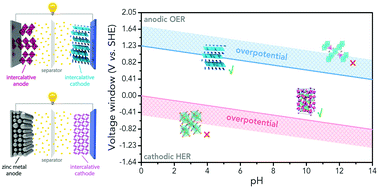当前位置:
X-MOL 学术
›
Chem. Soc. Rev.
›
论文详情
Our official English website, www.x-mol.net, welcomes your feedback! (Note: you will need to create a separate account there.)
Voltage issue of aqueous rechargeable metal-ion batteries.
Chemical Society Reviews ( IF 46.2 ) Pub Date : 2020-01-02 , DOI: 10.1039/c9cs00131j Zhuoxin Liu 1 , Yan Huang , Yang Huang , Qi Yang , Xinliang Li , Zhaodong Huang , Chunyi Zhi
Chemical Society Reviews ( IF 46.2 ) Pub Date : 2020-01-02 , DOI: 10.1039/c9cs00131j Zhuoxin Liu 1 , Yan Huang , Yang Huang , Qi Yang , Xinliang Li , Zhaodong Huang , Chunyi Zhi
Affiliation

|
Over the past two decades, a series of aqueous rechargeable metal-ion batteries (ARMBs) have been developed, aiming at improving safety, environmental friendliness and cost-efficiency in fields of consumer electronics, electric vehicles and grid-scale energy storage. However, the notable gap between ARMBs and their organic counterparts in energy density directly hinders their practical applications, making it difficult to replace current widely-used organic lithium-ion batteries. Basically, this huge gap in energy density originates from cell voltage, as the narrow electrochemical stability window of aqueous electrolytes substantially confines the choice of electrode materials. This review highlights various ARMBs with focuses on their voltage characteristics and strategies that can effectively raise battery voltage. It begins with the discussion on the fundamental factor that limits the voltage of ARMBs, i.e., electrochemical stability window of aqueous electrolytes, which decides the maximum-allowed potential difference between cathode and anode. The following section introduces various ARMB systems and compares their voltage characteristics in midpoint voltage and plateau voltage, in relation to respective electrode materials. Subsequently, various strategies paving the way to high-voltage ARMBs are summarized, with corresponding advancements highlighted. The final section presents potential directions for further improvements and future perspectives of this thriving field.
中文翻译:

水性可充电金属离子电池的电压问题。
在过去的二十年中,已经开发了一系列含水可充电金属离子电池(ARMB),旨在提高消费类电子产品,电动汽车和电网规模的储能领域的安全性,环境友好性和成本效率。但是,ARMB与有机对应物之间在能量密度上的显着差距直接阻碍了它们的实际应用,因此难以替换当前广泛使用的有机锂离子电池。基本上,这种能量密度的巨大缺口源自电池电压,因为水性电解质的狭窄电化学稳定性窗口实质上限制了电极材料的选择。这篇评论重点介绍了各种ARMB,重点是其电压特性和可以有效提高电池电压的策略。首先讨论限制ARMB电压的基本因素,即水性电解质的电化学稳定性窗口,它决定了阴极和阳极之间的最大允许电势差。下一节介绍了各种ARMB系统,并比较了各自电极材料的中点电压和平稳电压的电压特性。随后,总结了各种为高压ARMB铺平道路的策略,并重点介绍了相应的进步。最后一部分介绍了该领域蓬勃发展的进一步发展的潜在方向和未来前景。决定阴极和阳极之间的最大允许电势差。下一节介绍了各种ARMB系统,并比较了各自电极材料的中点电压和平稳电压的电压特性。随后,总结了各种为高压ARMB铺平道路的策略,并重点介绍了相应的进步。最后一部分介绍了该领域蓬勃发展的进一步发展的潜在方向和未来前景。决定阴极和阳极之间的最大允许电势差。下一节介绍了各种ARMB系统,并比较了各自电极材料的中点电压和平稳电压的电压特性。随后,总结了各种为高压ARMB铺平道路的策略,并重点介绍了相应的进步。最后一部分介绍了该领域蓬勃发展的进一步发展的潜在方向和未来前景。
更新日期:2020-01-02
中文翻译:

水性可充电金属离子电池的电压问题。
在过去的二十年中,已经开发了一系列含水可充电金属离子电池(ARMB),旨在提高消费类电子产品,电动汽车和电网规模的储能领域的安全性,环境友好性和成本效率。但是,ARMB与有机对应物之间在能量密度上的显着差距直接阻碍了它们的实际应用,因此难以替换当前广泛使用的有机锂离子电池。基本上,这种能量密度的巨大缺口源自电池电压,因为水性电解质的狭窄电化学稳定性窗口实质上限制了电极材料的选择。这篇评论重点介绍了各种ARMB,重点是其电压特性和可以有效提高电池电压的策略。首先讨论限制ARMB电压的基本因素,即水性电解质的电化学稳定性窗口,它决定了阴极和阳极之间的最大允许电势差。下一节介绍了各种ARMB系统,并比较了各自电极材料的中点电压和平稳电压的电压特性。随后,总结了各种为高压ARMB铺平道路的策略,并重点介绍了相应的进步。最后一部分介绍了该领域蓬勃发展的进一步发展的潜在方向和未来前景。决定阴极和阳极之间的最大允许电势差。下一节介绍了各种ARMB系统,并比较了各自电极材料的中点电压和平稳电压的电压特性。随后,总结了各种为高压ARMB铺平道路的策略,并重点介绍了相应的进步。最后一部分介绍了该领域蓬勃发展的进一步发展的潜在方向和未来前景。决定阴极和阳极之间的最大允许电势差。下一节介绍了各种ARMB系统,并比较了各自电极材料的中点电压和平稳电压的电压特性。随后,总结了各种为高压ARMB铺平道路的策略,并重点介绍了相应的进步。最后一部分介绍了该领域蓬勃发展的进一步发展的潜在方向和未来前景。


























 京公网安备 11010802027423号
京公网安备 11010802027423号